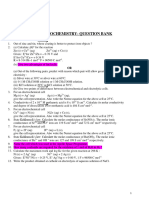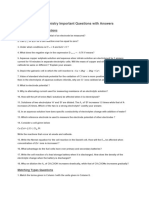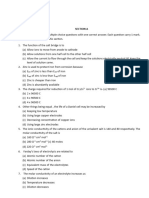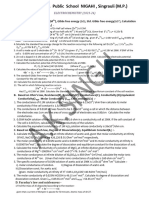Electrochemistry
Electrochemistry
Uploaded by
Kuldeep SharmaCopyright:
Available Formats
Electrochemistry
Electrochemistry
Uploaded by
Kuldeep SharmaOriginal Description:
Copyright
Available Formats
Share this document
Did you find this document useful?
Is this content inappropriate?
Copyright:
Available Formats
Electrochemistry
Electrochemistry
Uploaded by
Kuldeep SharmaCopyright:
Available Formats
AMITY INTERNATIONAL SCHOOL, MAYUR VIHAR,
REVISION ASSIGNMENT CLASS XII
TOPIC: ELECTROCHEMISTRY
1. If the amount of dissolved CO2 in water increases, it will:
a) increase the rate of corrosion b) decrease the rate of corrosion c) have no effect on the rate of corrosion
d) first decrease and then increase the rate of corrosion
2. The quantity of charge required to obtain one mole of Al fromAl2O3 is __________________.
3. Which of the following cell has cell potential independent of the concentration of the electrolyte?
a) Mercury cell b)Daniell ell c)Leclanche cell d)All of the above
4. The conductivity of molten NaCl is due to
a) Free ions b)Free electrons c)Free molecules d)Atoms of Na and Cl
5. The quantity of charge required to obtain one mole of aluminium from Al2O3 is
a)1F b)2F c)3F d)6F
6. Molar conductivity of ionic solution depends upon _______________.
a. Temperature b. distance between the electrodes c. Surface area of electrodes d. concentration of electrolytes
in solution.
7. While charging the lead storage battery _______________
a. PbSO4 anode is reduced to Pb. b. PbSO4 cathode is reduced to Pbc. PbSO4 anode is oxidized to PbO2.
d. PbSO4 cathode is oxidized to Pb.
8. An electrochemical cell behaves as an electrolytic cell when
a. Ecell = 0. b. Ecell > Eext. c. Ecell < Eext . d. Ecell = Eext.
9. The E0 of three metals X,Y,Z are + 0.5V. -0.3 V and – 1.2V respe ctively.The reducing
power of these metals are:
a. Y>Z> X b. Z>Y> X c. X > Z > Y d. X > Y > Z.
10. The oxidation state of nickel in nickel cadmium cell changes from ______ to _________.
11 . Zinc is able to displace silver from AgNO3 solution because its standard reduction potential
is_________ negative than that of silver.
12. The conductivity of an electrolytic solution __________ with decrease in number of ions.
13. The electric charge for the electrode deposition of 1 g – equivalent of a substance is _____ .
14. __________ electrode is an example of inert electrode.
15. The standard reduction potential for Zn2+(aq)/Zn(s) is -0.76 V. Write the electrode reactions when it is connected to SHE
(stahndard hydrogen electrode).
16.What do you mean by 'limiting molar conductivity'? What is its SI unit?
17.What is fuel cell? Give its two advantages over dry cell. Suggest two materials other than hydrogen that can be used as
fuels in fuel cell.
18. State Kohlrausch law of independent migration of ions.
19. Calculate the potential for half cell containing 0.10 M K2Cr2O7(aq), 0.2 M Cr3+(aq) and 1.0 X 10-4 M H+(aq). The half cell
reaction is
Cr2O72-(aq) + 14 H+(aq) + 6e- 2Cr3+(aq) + 7H2O(l The standard electrode potential is given as E0 = 1.33V.
20. Write the electrode reactions taking place in a
a) lead storage battery when it is discharged b) mercury cell c) dry cell
21. Resistance of a conductivity cell filled with 0.1 M KCl solution is 100 ohm. If the resistance of the same cell when filled
with 0.02 M KCl solution is 520 ohm, calculate conductivity and molar conductivity of 0.02 M KCl solution. The
conductivity of 0.1 M KCl solution is 1.29 X 10-2 per ohm per cm.
22. Explain graphically, the effect of dilution on the molar conductivity of a weak electrolyte and strong electrolyte
23. What will happen during the electrolysis of aqueous copper sulphate solution by using platinum
electrodes?
a) Copper will deposit at cathode b) Copper will deposit at anode c) Oxygen will be released at cathode.
d) Copper will dissolve at anode.
24. Λ02H2O m is equal to _______________.
(i) Λ0m(HCl) + Λ0m(NaOH) – Λ0m(NaCl) (ii) Λ0m(HNO3) + Λ0m(NaNO3) – Λ0m(NaOH) (iii) Λ0m(HNO3) + Λ0m(NaOH) – Λ0m(NaNO3)
0 0 0
(iv) Λ m(NH4OH) + Λ m(HCl) – Λ m(NH4Cl)
25. Match the items of Column I and Column II.
Column I Column II
(i) k (a) Ixt
(ii) ∧m (b) ∧m / ∧m0
(iii) α (c) k/c
(iv) Q (d) G*/R
26. A voltaic cell is set up at 250C with the half cells of Al3+ (0.001 M) and Ni2+ (0.50 M). Calculate the cell potential
generated by the cell when in use. The standard electrode potentials are given as
E0(Ni2+/Ni) = -0.25V and E0(Al3+/Al) = -1.66V
27. When a certain electrolytic cell was filled with 0.1 M KCl, it has resistance of 85 ohms at 250C. When the same cell
was filled with an aqueous solution of 0.052 M unknown electrolyte, the resistance was 96 ohms. Calculate the
conductivity and molar conductance of the unknown electrolyte at this concentration,
[ Specific conductance of 0.1 M KCl = 1.29 X 10-2 per ohm per cm].
28. Calculate the equilibrium constant of the reaction:
Cu(s) + 2Ag+(aq) → Cu2+(aq) + 2Ag(s) E ( cell ) = 0.46 V
29. the potential of hydrogen electrode in contact with a solution whose pH is 10.
30 Calculate the emf of the cell in which the following reaction takes place
Ni(s) + 2Ag+ (0.002 M) → Ni2+ (0.160 M) + 2Ag(s)
Given that EΘ(Cell) = 1.05 V
31 The cell in which the following reaction occurs:
2Fe3+ ( aq ) + 2I− ( aq ) → 2Fe2 + ( aq ) + I2 ( s ) has Ecell = 0.236 V at 298 K. Calculate the standard Gibbs energy and the
equilibrium constant of the cell reaction.
32. The conductivity of 0.001028 mol L–1 acetic acid is 4.95 × 10–5 S cm–1 . Calculate its dissociation constant if Ë°m for
acetic acid is 390.5 S cm2 mol–1.
33. A solution of Ni(NO3)2 is electrolysed between platinum electrodes using a current of 5 amperes for 20 minutes. What
mass of Ni is deposited at the cathode?
34. Three electrolytic cells A,B,C containing solutions of ZnSO4, AgNO3 and CuSO4,
respectively are connected in series. A steady current of 1.5 amperes was passed through them until 1.45 g of silver
deposited at the cathode of cell B. How long did the current flow? What mass of copper and zinc were deposited?
35. Unlike dry cell, the mercury cell has a constant cell potential throughout its useful life. Why?
36. Solutions of two electrolytes ‘A’ and ‘B’ are diluted. The Λm of ‘B’ increases 1.5 times while that of A increases 25
times. Which of the two is a strong electrolyte? Justify your answer.
37. Why on dilution the m of CH3COOH increases drastically, while that of CH3COONa increases gradually?
You might also like
- Ige TD 13Document73 pagesIge TD 13Anant RubadeNo ratings yet
- 2022 January University CatalogDocument1,329 pages2022 January University CatalogDan AmbroseNo ratings yet
- 2.electrochemistry QB (2023-24)Document6 pages2.electrochemistry QB (2023-24)Shana Chandran 18083No ratings yet
- ELECTROCHEMISTRYDocument5 pagesELECTROCHEMISTRYsarahNo ratings yet
- ELECTROCHEMISTRYDocument2 pagesELECTROCHEMISTRYayushkumarsinghh03No ratings yet
- Electrochemistry 1Document8 pagesElectrochemistry 1radhikase32No ratings yet
- Electrochemistry Past Papers 2022-14Document4 pagesElectrochemistry Past Papers 2022-1410 A Pratyush Dubey50% (2)
- Electrochemistry Past Papers 2022-14Document4 pagesElectrochemistry Past Papers 2022-14Venugopal JujhavarappuNo ratings yet
- ElectrochemistryDocument10 pagesElectrochemistryakshitha.s1313No ratings yet
- 12TH Grade Electrochemistry Worksheet-1Document3 pages12TH Grade Electrochemistry Worksheet-1Amen RaipurNo ratings yet
- MinrDocument5 pagesMinrrm0518502No ratings yet
- ElectrochemistryDocument6 pagesElectrochemistrytwinkleparmar0064No ratings yet
- 12 Electrochemistry Assignment-1Document4 pages12 Electrochemistry Assignment-1Yashraj NarwariyaNo ratings yet
- XII Chemistry MCQ Test Series 2 2023 2024 1698760736Document4 pagesXII Chemistry MCQ Test Series 2 2023 2024 1698760736bluewheel28No ratings yet
- Revision Worksheet 1 On Chapter ElectrochemistryDocument3 pagesRevision Worksheet 1 On Chapter Electrochemistrywww.luciannarikaNo ratings yet
- 10 FullDocument4 pages10 FullroobanNo ratings yet
- ELECTROCHEMISTRYDocument4 pagesELECTROCHEMISTRYSAIRAJ PRABHAKAR PAWARNo ratings yet
- Electrochemistry (2010-2024)Document5 pagesElectrochemistry (2010-2024)soofia baufelNo ratings yet
- CHE1010 Tutorial Sheet 5Document4 pagesCHE1010 Tutorial Sheet 5Chimuka Onson MapikiNo ratings yet
- Electrochemistry AssignmentDocument3 pagesElectrochemistry Assignmentfkgamer4455No ratings yet
- Electrochemistry: 2 303 G - RtlogkDocument7 pagesElectrochemistry: 2 303 G - RtlogkSnehashis BoseNo ratings yet
- Unit 3 ElectrochemistryDocument7 pagesUnit 3 ElectrochemistrySapna 2704No ratings yet
- Electro ChemistryDocument7 pagesElectro ChemistryStuti KarnNo ratings yet
- MCQinelectrochemistry 64143Document5 pagesMCQinelectrochemistry 64143Echo borgNo ratings yet
- Electrochemistry problemsDocument4 pagesElectrochemistry problemsshashwanth017No ratings yet
- ElectrochemistryDocument17 pagesElectrochemistryzohaibsalamNo ratings yet
- Electrochem Question NewDocument9 pagesElectrochem Question NewrjakrithiNo ratings yet
- Chapter-Wise Test: Class-XII Chapter-ElectrochemistryDocument2 pagesChapter-Wise Test: Class-XII Chapter-ElectrochemistrySaikat PodderNo ratings yet
- 3 Electrochemistry Assignment 1Document9 pages3 Electrochemistry Assignment 1Unknown GamerNo ratings yet
- ElectrochemistryDocument6 pagesElectrochemistryaxiliya6No ratings yet
- ELECTROCHEMISTRY mcqsDocument5 pagesELECTROCHEMISTRY mcqskartikyadav2655No ratings yet
- Pratice Test - 2Document2 pagesPratice Test - 2yaxpatel41No ratings yet
- Electrochemistry PreparatoryDocument4 pagesElectrochemistry Preparatorynithinkumarin2006No ratings yet
- Electrochemistry Board Questions 2010Document4 pagesElectrochemistry Board Questions 2010amone nNo ratings yet
- unit 3 ElectrochemistryDocument7 pagesunit 3 Electrochemistryayush.gamingvlogsNo ratings yet
- IMP ElectrochemistryDocument5 pagesIMP ElectrochemistryShan PanwarNo ratings yet
- Electro Che Long Answer 1Document3 pagesElectro Che Long Answer 1SnehaNo ratings yet
- ElectrochemistryDocument3 pagesElectrochemistryKeshav GuptaNo ratings yet
- Special Class Electro Chemistry 23Document19 pagesSpecial Class Electro Chemistry 23sheetal10swetaNo ratings yet
- Electrochemistry AssignmentDocument4 pagesElectrochemistry AssignmentIMMORTAL GAMERNo ratings yet
- ElectrochemistryDocument4 pagesElectrochemistrylsanthijeyNo ratings yet
- Electrochemistry Uti Module 3Document8 pagesElectrochemistry Uti Module 3arunarajeshwaryNo ratings yet
- ELECTROCHEMISTRYDocument2 pagesELECTROCHEMISTRYShivaanee SKNo ratings yet
- Electrochemistry 12THDocument12 pagesElectrochemistry 12THaayanNo ratings yet
- Chemistry ch-3Document19 pagesChemistry ch-3DeekshaNo ratings yet
- 2 QB Electrochemistry24-25Document6 pages2 QB Electrochemistry24-25mailltempp28No ratings yet
- Electrochemistry: E° (Cathode) - E° (Anode) G - nFE F 96,485J/ V X Mols G GDocument15 pagesElectrochemistry: E° (Cathode) - E° (Anode) G - nFE F 96,485J/ V X Mols G GandrewNo ratings yet
- Eletrochemistry Previous Qns With AnswersDocument8 pagesEletrochemistry Previous Qns With AnswersAkshay SureshNo ratings yet
- XIIElectrochemistryDocument3 pagesXIIElectrochemistryAyush KumarNo ratings yet
- Assignment Electro Chemistry 2024-25Document2 pagesAssignment Electro Chemistry 2024-25akshatdas08No ratings yet
- Unit 3 ElectrochemisrtyDocument7 pagesUnit 3 ElectrochemisrtyRahgul M.S.50% (2)
- Screenshot 2024-04-23 at 11.37.37 PMDocument6 pagesScreenshot 2024-04-23 at 11.37.37 PMarnav.kashyap9396No ratings yet
- Revision - Electrochemistry (Cbse 2023)Document2 pagesRevision - Electrochemistry (Cbse 2023)Sahana BanuNo ratings yet
- Question Paper ElectrochemistryDocument7 pagesQuestion Paper Electrochemistryvineshuniyal19No ratings yet
- C 2 Amal 1 Galvanic 2017Document16 pagesC 2 Amal 1 Galvanic 2017kjjkimkmkNo ratings yet
- 5 MARKS QUESTIONs PYQs CH 3Document2 pages5 MARKS QUESTIONs PYQs CH 3xefayo4337No ratings yet
- Che 323 Problem Set 6: Electrochemistry March 12, 2014 Engr. May V. Tampus ConceptsDocument1 pageChe 323 Problem Set 6: Electrochemistry March 12, 2014 Engr. May V. Tampus ConceptsLouie G NavaltaNo ratings yet
- 10-Class - XII (Electrochemistry)Document4 pages10-Class - XII (Electrochemistry)farazkhan826afNo ratings yet
- Electro Chemistry (QB)Document4 pagesElectro Chemistry (QB)Akshith ReddyNo ratings yet
- Question BankDocument4 pagesQuestion BankNagaraj Periasamy100% (2)
- 6272226-Class 12 - Chemistry - Electrochemistry - WS With Ans. - JeneshaDocument8 pages6272226-Class 12 - Chemistry - Electrochemistry - WS With Ans. - Jeneshahari6127ffNo ratings yet
- Practice Makes Perfect in Chemistry: Oxidation-ReductionFrom EverandPractice Makes Perfect in Chemistry: Oxidation-ReductionRating: 5 out of 5 stars5/5 (1)
- Ship Construction Kemp& Young - CompressedDocument67 pagesShip Construction Kemp& Young - CompressedKuldeep SharmaNo ratings yet
- ProjectDocument2 pagesProjectKuldeep SharmaNo ratings yet
- 12 Chemistry MCQ - 02-08-2019Document38 pages12 Chemistry MCQ - 02-08-2019Kuldeep SharmaNo ratings yet
- World Smartest KidsDocument1 pageWorld Smartest KidsKuldeep SharmaNo ratings yet
- New Class ImplementationDocument2 pagesNew Class ImplementationKuldeep SharmaNo ratings yet
- Syllabus: Nervous System 1: Group 6Document6 pagesSyllabus: Nervous System 1: Group 6'Ia Coca CresencioNo ratings yet
- Focused Microwave-Assisted Extraction of COCA PDFDocument8 pagesFocused Microwave-Assisted Extraction of COCA PDF19simon85No ratings yet
- Human Communicationchap14 TestDocument37 pagesHuman Communicationchap14 Testdurubelsan02No ratings yet
- Geotechnical Engineering Office, Civil Engineering and Development Department The Government of The Hong Kong Special Administrative RegionDocument16 pagesGeotechnical Engineering Office, Civil Engineering and Development Department The Government of The Hong Kong Special Administrative RegionVince KongNo ratings yet
- MARINE ConcreteDocument12 pagesMARINE ConcreteChristian Bar100% (1)
- Amazfit GTS 2 Mini User GuideDocument32 pagesAmazfit GTS 2 Mini User GuideBarney RossNo ratings yet
- Failure Analysis Report - DT 2339 Suspension LH Rev1Document8 pagesFailure Analysis Report - DT 2339 Suspension LH Rev1Eng PLM ACPNo ratings yet
- Manipura MeditationDocument3 pagesManipura Meditationprashant_dc_in100% (1)
- Consignment Note For Scheduled WasteDocument1 pageConsignment Note For Scheduled WasteNordalilah Mohd SobriNo ratings yet
- WEEK 5 LAB EXERCISE - Skeletal SystemDocument19 pagesWEEK 5 LAB EXERCISE - Skeletal SystemChristian GallardoNo ratings yet
- November 28, 1953 - What HappenedDocument7 pagesNovember 28, 1953 - What HappenedJames BradleyNo ratings yet
- Ebook - FDA-approved Drugs That Interfere With Laboratory Teste PDFDocument49 pagesEbook - FDA-approved Drugs That Interfere With Laboratory Teste PDFhector zeroni100% (1)
- Industrial Chemistry Henry Kreitzer (Ebooksread - Com)Document547 pagesIndustrial Chemistry Henry Kreitzer (Ebooksread - Com)Pyae Sone KyawNo ratings yet
- Tle Lesson 2-Nutritional Values and Components of EggDocument3 pagesTle Lesson 2-Nutritional Values and Components of Eggqwerty AGNANo ratings yet
- UntitledDocument22 pagesUntitledHamzaoui abd essalemNo ratings yet
- Application of Biotechnology in Medicine (Powerpoint)Document16 pagesApplication of Biotechnology in Medicine (Powerpoint)janelleturla22No ratings yet
- White Blue Simple Full Stack Developer CV ResumeDocument1 pageWhite Blue Simple Full Stack Developer CV Resumehussymian06No ratings yet
- Cross Section Cross Section: Bureau of DesignDocument1 pageCross Section Cross Section: Bureau of DesignMNo ratings yet
- Introduction To Heat Exchangers PDFDocument44 pagesIntroduction To Heat Exchangers PDFkamelNo ratings yet
- Axial Fans CostechDocument14 pagesAxial Fans CostechEfra BlancoNo ratings yet
- Local Ref 275 1489985804118Document116 pagesLocal Ref 275 1489985804118Alok Kumar GautamNo ratings yet
- AI in Pharmaceutical IndustryDocument3 pagesAI in Pharmaceutical IndustryKabirNo ratings yet
- ''Magnets in Orthodontics''Document102 pages''Magnets in Orthodontics''Anubha VermaNo ratings yet
- Endocrine UnlockedDocument30 pagesEndocrine Unlockedelsharkaoui211No ratings yet
- TI - How To Identify STC & LTCDocument2 pagesTI - How To Identify STC & LTCmorefast3No ratings yet
- Tcp50s60 Panasonic ServiceDocument55 pagesTcp50s60 Panasonic ServiceJim EzellNo ratings yet
- PE10 Q1 - Mod1 - Active Recreation Sports Lesson 1 7 - v3Document85 pagesPE10 Q1 - Mod1 - Active Recreation Sports Lesson 1 7 - v3Macquen BalucioNo ratings yet
- W-2-Sevigny-Basic ECG PDFDocument61 pagesW-2-Sevigny-Basic ECG PDFdheaNo ratings yet






























































































